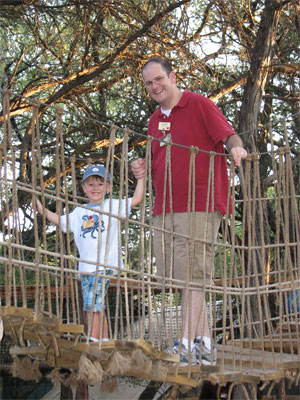The Little Engine That Could as Myth?
I have had many conversations about what exactly “myth” is over the last few years. I believe now that whether or not a particular story counts as “myth” is relative to a given person; a given story could be a “myth” to one person and not to another person. My ideas on this are not all worked out yet, but I think that the primary determining factor is the role that a story plays in the life of the person or the community. I had an experience over the weekend that reminded of this.
We visited the summer camp where my wife and I met last weekend. I had a fun time playing with my four-year-old son on a treehouse playground. He was feeling adventurous but also nervous as he approached the swinging rope bridge. I held his hand and encouraged him as he inched along. He started to chant something like a mantra to himself: “I think I can, I think I can, I think I can.” This chant gave him the courage to finish crossing the bridge. (Here’s a photo of us on a later trip across the bridge, when he was more comfortable.)

You probably recognize this chant from “The Little Engine That Could.” I don’t know anyone who would consider that story a “myth”; I imagine “fable” is the highest status any literary scholars would be willing to grant it. But for my son that day, this story was so much more than just a fable; the little engine was so much more than just a positive example. This story had gotten under his skin and made its way to the core of his being. In a difficult circumstance, he tapped into the power of narrative to bring about a psychological transformation. For me, the story is a childish, uninspiring fable; but for my son, this story played the role of myth in his life.